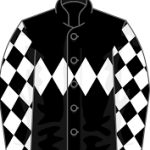 Without a good riding jacket, you can be cold, wet, wind-burnt, sun-burned and injured. The riding jacket separates the pro’s from the bro’s. A motorcycle jacket has no hood, as the helmet keeps the head dry. A jacket is your most expensive gear, but after the helmet it is the most important for safety so it pays to get it right. It costs the most because it must be
Without a good riding jacket, you can be cold, wet, wind-burnt, sun-burned and injured. The riding jacket separates the pro’s from the bro’s. A motorcycle jacket has no hood, as the helmet keeps the head dry. A jacket is your most expensive gear, but after the helmet it is the most important for safety so it pays to get it right. It costs the most because it must be
- Protective: Rip proof, absorbs damage, protection pads.
- Warm: Good insulation, internal winter wool insert.
- Waterproof: Pocket flap seals, closed wrists and collar, zip overlays.
- Ventilated: Breathable material, back vents, underarm vents.
- Wearable: Not too heavy, stays clean, adjustable waist, nice design.
- A carryall: Wallet pocket, map pockets, side pockets, inside pockets.
Protective
The many types of jacket material include:
- Leather
- Polyvinyl or nylon
- Synthetic
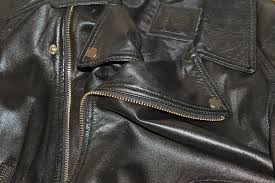
Leather motor-cycle jackets can be heavy, bulky and not entirely waterproof (the leather jacket one wears to a club is not a motor-cycle jacket). Leather tends to be expensive, but is warm, and does one thing well – protect in a fall. Leather protects as skin does, by absorbing an attack. If you hit the pavement, the jacket rips but you don’t – it takes the hurt for you. The gravel bits stick in the jacket, not your skin, which is good.
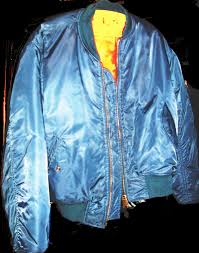
Polyvinyl or vinyl is the cheaper alternative to leather. Originally designed for road-side workers, rain suits often come in glaring colors, like yellow or orange. They arent designed to absorb impact in a fall. Polyvinyl is fully waterproof and tough, but being thin tends to just rip in a fall. It also isn’t that warm and doesn’t “breathe”, so in summer it can feel like your in an incubator. Wearing a woolly jumper under a vinyl jacket is a cheap way to add warmth and improve fall protection.
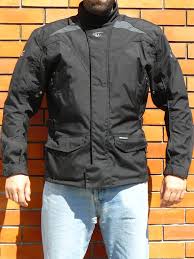
Synthetic jackets are the ideal motor-cycle solution. If you can afford a quality synthetic jacket get one – they are worth it. They breathe, are fully waterproof, are warm and give at least as much protection as leather. They are made of Gore-tex, a Kevlar like material used in bullet proof vests, and have protective pad inserts at important “hit points” like the elbows. Finally they have great pockets to carry all sorts of stuff. Synthetic jackets are expensive, but worth it.
Waterproof
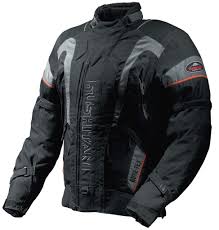
You find out if a jacket is waterproof or not when it rains heavily and you have some distance to travel. You feel a damp spot, often beginning at the front where the rain hits, that slowly spreads. For jackets, the fabric may be waterproof, but leakage occurs at the joints, especially the main front zip or button up. The more joints (zips and pockets) a jacket has, the more places it can leak. Good jackets have a waterproof flap system that covers the zips to ensure they don’t leak, held in place by Velcro or metal clips. On a water-proof jacket, all zips and water entry points have covering flaps, so you cant see the main zips directly. Velcro straps on the wrists close up stop water entering there. Likewise the neck needs a button up Chinese collar, to cover and seal with a pull-around Velcro strap. Does all this matter? When you are traveling for an hour in solid rain it does!
Warm
Most jackets are lined inside to be warm, so I wouldnt get a jacket with no lining at all. Air flow has a wind chill effect, so if you ride at speed in cold weather, it is much colder. The windchill can easily be below zero even if the actual temperature is not. Unfortunately, a heavy jacket for winter it is not pleasant in hot summer, and vice-versa. Some jackets let you get the best of both worlds, with an inner lining both for body that can be unzipped and removed in summer when it is hot. I usually get this type, as they cost more but it is cheaper than buying two jackets!
Ventilated
Ventilation is how well a jacket handles warm weather. A jacket needs to “breathe”, or let air in and out. A vinyl jacket is impermeable to water, but also to air. On a hot day the body generates water as perspiration. Vinyl keeps outside water (like rain) out, but it also keeps inside water (perspiration) in. On a hot day you can be wet from sweat not rain. A good jacket keeps rain out but still breathes, due to zip vents that allow airflow at the back or sides, where rain does not come in.
Wearable
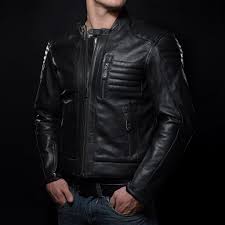
Most fashion leather jackets are wearable around but neither warm nor waterproof on a motorcycle, as they have open fronts and collars. It is hard to get riding functionality and good looks in a single jacket. A wearable motorcycle jacket is one that still looks good when you get off the bike, so you can walk around in it without looking to out of place. Heavy or bulky jackets that make you look like a polar explorer are not “cool”. Leather jackets that look good are often too short to cover your bottom part, especially for tall people like me. When it rains, the water runs down goes to the groin and a wet crotch is not cool. In the picture of a cool leather jacket, note that it stops a few inches short of his belt, so even with leggings, in the crouch position on a bike the water is going to go in there.
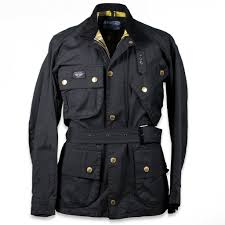
Synthetic jackets are longer to cover better, and look good if they have a fitted look. They also come in various design colors and styles. To justify the cost, you are getting two jackets in one, one to ride and one to walk around in. And the material does not fade – even after years they look as new.
A carryall
A motorcycle jacket needs waterproof pockets, including:

- Wallet pocket: In the old days getting out your wallet with a motorcycle jacket on was a major undertaking. Today’s jackets have a zipped breast pocket that sits outside the main front zip, so you can pull out your wallet without unbuttoning the jacket at all.
- Front map pockets: These can hold a large flat object, like a map, and are very deep. To get at the map requires opening a side zip or Velcro rip.
- Side pockets: If zipped with a Velcro flap, they can hold items like toll booth coinage or tire gauge, on both sides.
- Inside Pockets: Have to open the jacket to get at these pockets, but they are useful to keep things really safe and dry, like for example your license or insurance.
A jacket can carry the things you need, from lip chap to map, and keep them dry if it rains.